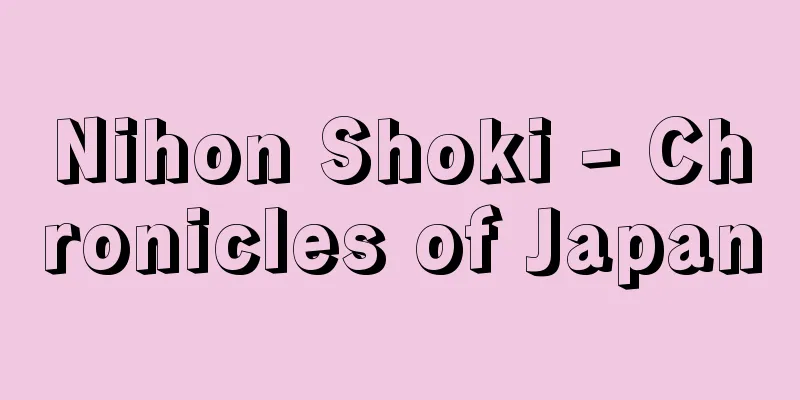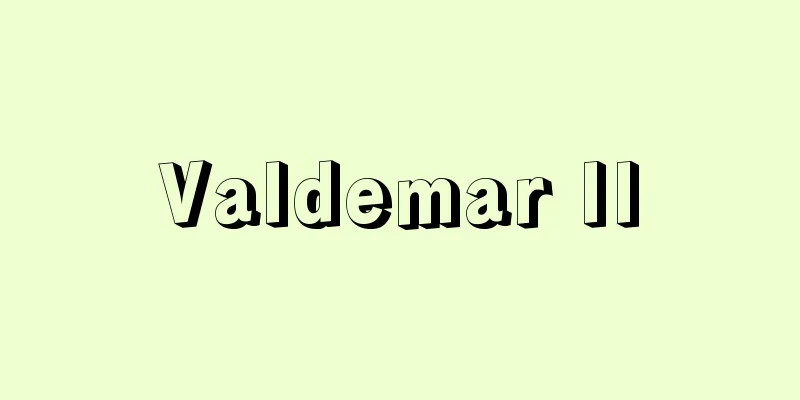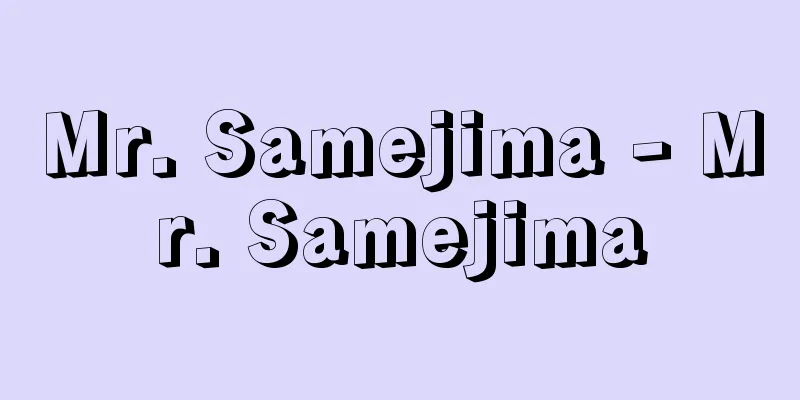Nihon Shoki - Chronicles of Japan

|
Published in 720 (Yoro 4), this is the first official history of Japan. It is the first of the Six National Histories. It is written in classical Chinese and chronological order, covering the period from the Age of the Gods to the reign of Empress Jito. [Hiromichi Mayuzumi] Book titleWhen it was first compiled, it was called "Nihon Shoki," but it is believed that it began to be called " Nihon Shoki " around the beginning of the Heian period. "Nihon Shoki" is also a common noun meaning national history, that is, a historical book compiled by imperial decree, and the second national history compiled in the early Heian period was called "Shoku Nihongi," so perhaps it was deliberately called "Nihon Shoki" to emphasize that the first " Nihon Shoki " (official history) was the official history. However, there is still no clear explanation as to why the character "sho" was added. [Hiromichi Mayuzumi] EstablishedThe date of its creation is clear from the entry for May 21st, Kinototori (720) in the "Shoku Nihongi," which reads, "Earlier, Prince Ippontoneri compiled the Nihongi in accordance with imperial decree. This was a successful report. The chronicle consists of 30 volumes and one volume of genealogy," but the date and process of its compilation are not necessarily clear. The entry for the 17th day of the third month of the 10th year of the reign of Emperor Tenmu (681) in the "Nihon Shoki" reads, "The Emperor... issued an edict to Prince Kawashima and Prince Osakabe (the Ten Abbreviated), and established the Imperial Chronicles and various ancient matters," and we know that Emperor Tenmu gave orders to Prince Kawashima and others to begin the project of compiling history books. On the other hand, the preface to the "Kojiki" also states that Emperor Tenmu ordered the toneri Hieda no Are to learn and recite the "Teio no Hitsugi" (Imperial Chronicles) and the "Sendai Ikuji." Theories are divided on whether the compilation projects seen in the two books, the Kojiki and the Nihon Shoki, are considered to be the same or different; if they are separate, the relationship between the two becomes an issue, but due to a lack of historical materials, no conclusive theory has yet emerged. Hirata Atsutane considers the two to be the same, but there is a huge disparity between the impressive lineup of the princes and Hieda no Arei alone, and it is difficult to believe that they were the same project. The first seems to be a public project, while the other is a private one. The theories that consider the things mentioned in the Kojiki and Nihon shoki to be separate include the first and second Kojiki theory. The compilation project ordered in 681 did not progress as expected, so the emperor started the work of writing the Kojiki again with Arei. According to this, the project in 681 can be said to be a distant cause of the compilation of the Kojiki, but it is not its direct origin. Next, there is the second Kojiki theory. In other words, when the emperor found that the work he started with Arei was unexpectedly time-consuming, he ordered Prince Kawashima and others to start a separate compilation project. This leads to the compilation of the Shoki, and the part where Arei recited the Kojiki separately came to fruition. In addition, there is a theory that it is difficult to believe that the compilation of the Nihon Shoki was intended from the beginning in 681, and that the start of the compilation of the Nihon Shoki can be traced back to the article in the Shoku Nihongi for February, Year 1 of the Wadou Era (714), entitled "Kinoason Kiyohito, Senior Rank 6, and Miyake no Omi Fujimaro, Senior Rank 8, were ordered by the Imperial Court to be compiled into a national history book." However, the difficulty is that the official ranks of the Kiyohito and others were too low, and so in the end, the theory that it was compiled in the Kizen and Kisho periods seems the most plausible at present. [Hiromichi Mayuzumi] Compiled byAs mentioned above, the chief editor of the Nihon Shoki was Emperor Tenmu's son, Prince Toneri, and it was compiled during the reign of Tenmu's granddaughter, Empress Gensho. The Dai Nihonshi claims that the Nihon Shoki ignored Prince Otomo's accession to the throne, but regardless of whether this is true or not, it cannot be denied that Tenmu's side's claims were strongly reflected in the Nihon Shoki. In addition, the theory that emphasizes the influence of Fujiwara no Fuhito, a powerful figure at the time of compilation, has become popular recently, but it should not be overestimated. [Hiromichi Mayuzumi] Compilation materialsWhile the Kojiki was based only on the Imperial Chronicles and the Old Records, and attempted to determine one correct theory among the various theories and make it coherent, the Nihon Shoki not only used the Imperial Chronicles and the Old Records, but also used a wide range of materials, such as family annals, government records, personal diaries, temple legends, Korean historical materials, and Chinese historical records, and quoted Chinese classics and Buddhist scriptures abundantly to organize the text. Moreover, instead of forcing the different theories to be unified, they were written together in a single book, or added as notes, and sometimes the author wrote that he awaited future revisions. This may be considered an objective and fair attitude from an academic point of view, but as an official national history, it leaves something to be desired in terms of its appearance. Immediately after its creation, the study of the Nihon Shoki was actively carried out in the form of lectures at the Imperial Court, and many "private notes" were created, but from the Middle Ages onwards, Shinto research into the Kamiyo no Ki was flourishing, leading to the reverence of the text as a divine scripture, and giving rise to mystical interpretations of the text. This tendency continued into modern times, hindering scientific research into the text, but it was only after World War II that it was rectified. [Hiromichi Mayuzumi] "Nihon Shoki, 6 volumes, annotated by Takeda Yukichi (1948-1957, Asahi Shimbun, Complete Collection of Japanese Classics)" ▽ "Tsuda Sokichi, Studies of Japanese Classics, Volumes 1 and 2 (1963, Iwanami Shoten)" ▽ "Nihon Shoki, Volumes 1 and 2, annotated by Sakamoto Taro et al. (Japanese Classical Literature Series 67 and 68, 1965, 1967, Iwanami Shoten)" ▽ "Nihon Shoki, Volumes 1 and 2, edited by Kuroita Katsumi (New Revised and Supplemented National History Series, Popular Edition, 1971, Yoshikawa Kobunkan)" [References] | |Source: Shogakukan Encyclopedia Nipponica About Encyclopedia Nipponica Information | Legend |
|
720年(養老4)に成立した日本初の正史。いわゆる六国史(りっこくし)の第一。神代より持統(じとう)天皇の代までを漢文で編年体に記す。 [黛 弘道] 書名成立当初「日本紀(にほんぎ)」とよばれたが、平安初期のころから「日本書紀」とよぶようになったと推測される。「日本紀」が国史すなわち勅撰(ちょくせん)の歴史書という普通名詞でもあり、また平安初期に成立した第二の国史を「続日本紀(しょくにほんぎ)」といったので、最初の「日本紀」(正史)をとくに強調するため、わざわざ『日本書紀』といったのではあるまいか。しかし、なぜ「書」の字を加えたか、いまだ適確な説をみない。 [黛 弘道] 成立その成立時期については『続日本紀』の養老(ようろう)4年(720)5月癸酉(きのとのとり)(21日)条に「先是(これよりさき)、一品舎人親王(いっぽんとねりしんのう)奉勅修日本紀。至是功成奏上。紀卅巻、系図一巻」とあるので明らかであるが、編纂(へんさん)開始の時期や編纂の経緯はかならずしも明らかでない。『日本書紀』の天武(てんむ)天皇10年(681)3月丙戌(ひのえのいぬ)(17日)条に「天皇……詔川嶋(かわしま)皇子・忍壁(おさかべ)皇子(十人略)、令記定帝紀(ていき)及上古諸事」とみえ、天武天皇が川嶋皇子以下に命じて歴史書編纂事業を開始したことが知られるが、一方、『古事記』序文にも天武天皇が舎人稗田阿礼(ひえだのあれ)に命じて「帝皇日継(ていおうのひつぎ)」(帝紀)と「先代旧辞(せんだいくじ)」を誦(よ)み習わせたということがみえる。記紀の2書にみえる編纂事業を同じものとみるか別と考えるかで説が分かれるし、別とすれば両者の前後関係も問題となるが、史料の不足もあっていまだ決定的な説は現れない。 平田篤胤(ひらたあつたね)は両者を同じこととするが、皇子以下の堂々たる陣容と稗田阿礼1人とでは格差がありすぎ、とうてい同一事業とは思えない。一は公的、他は私的事業の感が深い。記紀にいうところを別事とみる説では、まず紀前記後説がある。681年に命じた編纂事業が思うように進捗(しんちょく)しなかったので、天皇は改めて阿礼を相手に記定事業を始めた、というもので、これによれば681年の事業は『古事記』編纂の遠因とはいえるが、直接の起源ではない。次に記前紀後説がある。つまり阿礼を相手に始めた作業が意外に手間取ることを知った天皇は、川嶋皇子以下に命じ別途に編纂事業を開始させた。これが書紀編纂につながるもので、それとは別に阿礼の誦習(しょうしゅう)するところは『古事記』として結実したと説くものである。 なお、681年の当初から『日本書紀』編纂が意図されたとは考えがたいとして、書紀編纂の開始を『続日本紀』和銅(わどう)7年(714)2月戊戌(つちのえのいぬ)条の「詔従(じゅ)六位上紀朝臣(きのあそん)清人(きよひと)、正八位下三宅臣(みやけのおみ)藤麻呂(ふじまろ)、令撰国史」の記事に求める説もある。しかし、清人らの官位が低すぎるのが難点であり、結局目下のところ記前紀後説がもっとも穏当と思われる。 [黛 弘道] 編纂者先述のごとく編纂総裁は天武天皇皇子舎人親王であり、成立は天武の皇孫元正(げんしょう)女帝の時代である。『日本書紀』が大友皇子の即位を無視したとは『大日本史』の主張であるが、その当否はともかく、天武側の主張が『日本書紀』に強く反映されたであろうことは否定できない。また、編纂当時の実力者藤原不比等(ふひと)の影響を重視する説も近ごろでは人気があるが、過大評価は禁物である。 [黛 弘道] 編纂資料『古事記』が帝紀と旧辞だけを素材とし、しかも諸説のうち一つの正説を定めて筋を通そうとしたのに対し、『日本書紀』は帝紀、旧辞はいうに及ばず、その他諸家の家記、政府の記録、個人の日記手記、寺院の縁起類、朝鮮側史料、中国史書など多方面にわたる資料を活用し、文章を整えるためにも漢籍、仏典を豊富に引用している。しかも異説を強いて統一せず、一書という形で併記したり、注として付記し、ときに後人の勘校に俟(ま)つ旨を記す。これは、学問的には公平客観的な態度とされようが、国家の正史としては、体裁の面で遺憾なしとしない。『日本書紀』の研究は、成立直後から宮廷における講読という形で盛んに行われ、多くの「私記」がつくられたが、中世以降、神代紀の神道(しんとう)的研究が盛んとなり、これを神典として崇(あが)めるに至り、記紀の神秘的解釈を生じた。この傾向が近代に及び、記紀の科学的研究を阻むことにもなったが、第二次世界大戦後ようやく是正された。 [黛 弘道] 『武田祐吉校注『日本書紀』全6巻(1948~1957・朝日新聞社・日本古典全書)』▽『津田左右吉著『日本古典の研究 上下』(1963・岩波書店)』▽『坂本太郎他校注『日本書紀 上下』(『日本古典文学大系67・68』1965、1967・岩波書店)』▽『黒板勝美編『日本書紀 前・後編』(『新訂増補国史大系』普及版・1971・吉川弘文館)』 [参照項目] | |出典 小学館 日本大百科全書(ニッポニカ)日本大百科全書(ニッポニカ)について 情報 | 凡例 |
<<: Commentary on the Nihon Shoki
>>: Japanese Folk Culture Research Institute
Recommend
Ortega, S.
...Resistance songs created in various countries ...
Grey-headed lapwing (English spelling) Vanellus cinereus; grey-headed lapwing
Charadriiformes, Charadriidae. Total length 34-37c...
Male entertainment - nanshokumono
In a narrow sense, it refers to a type of kana zos...
Dense - dense
〘Noun〙① (adjective-verb) (━suru) A large number of...
Phoca groenlandica; harp seal
Order Carnivora, Suborder Pinnipedia, Family Phoci...
Daveluy, MAN (English spelling) DaveluyMAN
...Later, he wrote "History of Christianity ...
Yatabe
A district in the southwest of Tsukuba City, Ibar...
Baldensperger, F.
… [Development of the French Positivism] In the 2...
Takato Oki - Takato Oki
Year of death: September 26, 1899 (Meiji 32) Year ...
Apparent solar day
...A general term for true solar days and mean so...
Yasukatsu - Koushou
A Buddhist sculptor of the main line of the Kei sc...
Okatasagoto - Okatasagoto
...Since the act of pretending is an imitation of...
procureur du roi (English)
…While judges are indispensable in trials, prosec...
Tourist inn - Kankoryokan
…With the development of railways after the Meiji...
White paper - Hakucho
A type of official clothing worn by lower-ranking...



![Matsubase [town] - Matsubase](/upload/images/67cce7f46c4f1.webp)





